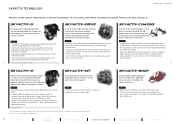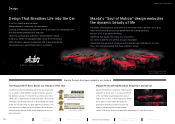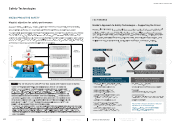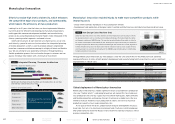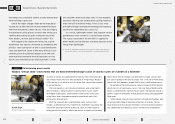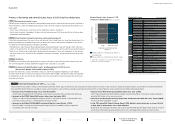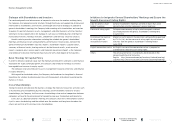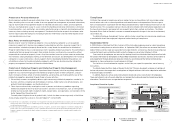Mazda 2016 Annual Report Download - page 29
Download and view the complete annual report
Please find page 29 of the 2016 Mazda annual report below. You can navigate through the pages in the report by either clicking on the pages listed below, or by using the keyword search tool below to find specific information within the annual report.
Jinba-ittai
Academy
Global co-creation activity to convey
driving pleasure to customers
The
Jinba-ittai
Academy is a training program
launched in the March 2014 fiscal year to cultivate
human resources who are able to convey driving
pleasure to customers. Led by instructors with spe-
cialist knowledge in the field of driving, the program
adopts a hands-on test drive style using Mazda and
competitors’ vehicles. Originally started in Japan,
we began rolling out this program globally in the
March 2016 fiscal year, with participants now com-
prising not only Mazda employees but also overseas
sales staff members.
As a Group-wide co-creation activity, all persons
involved with Mazda vehicles, from manufacturing
to showrooms, work to deliver to customers the driv-
ing pleasure that is the value that Mazda creates.
highly rigid, slim body shape. After overcoming these
conditions and pursuing an ideal shape, the solution
was derived.
*2 NVH: A standard used to estimate the comfort of an automobile, standing for noise,
vibration, and harshness.
At the same time, this idea posed a major challenge for
the production technology teams involved in mass produc-
tion, including their planning and designing of the
manufacturing process for the new vehicle. The previous
production method was based on the concept of a uniform
thickness for the entire transmission case, for ease of
production and to ensure quality. The development pro-
posal based on the idea of using the minimum-required
thickness in each place was therefore a major change from
the previous method, which made it extremely difficult to
ensure product quality and performance.
Kouji Furutani and Hirokazu Oishi of the division in
charge of casting and mold technology thoroughly
analyzed the diagram drawn up by the development
division to achieve a
Jinba-ittai
drive that would sur-
pass customer expectations, and they made a number
of proposals based on Mazda’s proprietary die cast
technology.*3 They commented:
“Monotsukuri Innovation aims to offer customers
more value and reduce costs at the same time. To
reproduce the complicated shape of the transmission
case accurately, our mission was to enhance function-
ality by drastically raising the machining accuracy in
the manufacturing process, while providing customers
with reliable product quality at an affordable price.”
By having the development and manufacturing
divisions work closely together from the early stages
of the design process, we were able to make a high-
quality, thin transmission case that is lightweight, rigid,
and compact, at a lower cost.
With the entire Company working as one to deliver
a
Jinba-ittai
sense of driving pleasure to customers, we
developed a new transmission that is the industry’s
lightest in its class.
*3 A casting technology that combines a proprietary highly rigid mold based on a
high-speed, powerful vacuum die cast, with cooling technologies, sensing
technologies, and on-site maintenance, which makes the consistent production of
thin, stable shapes possible.
Nobukawa, Furutani, and Oishi comment, “This
transmission case was only a start. Production and
development will continue to work together to pursue
performance and eliminate waste to achieve even
lighter and higher-quality products.”
CLOSE UP
Cross-section of the manual transmission
case in the previous model, which used a
conventional uniform thickness (4.5mm)
Jinba-ittai
Academy for sales staff in Chile
Cross-section of the new MX-5’s manual
transmission case, which uses a three-
dimensional thickness allocation
(2.5mm–8.0mm in this view) for a
minimum thickness needed for each
section, to achieve a lightweight, slim
body shape while maintaining rigidity
Development Divisions Manufacturing Divisions
Uniform thickness (4.5mm) Minimum thickness (2.5mm)
MAZDA ANNUAL REPORT 2016
27 Drivers of Value Creation
Message from
Management
Review of Operations
Foundations Underpinning
Sustainable Growth
Financial Section
Contents


